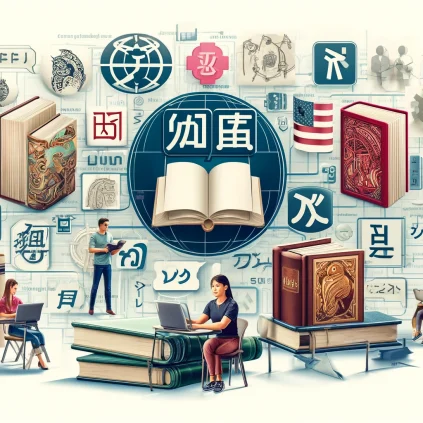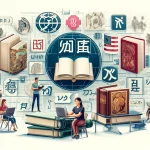The translation and localization of Western literature for Asian audiences involve much more than a straightforward conversion of text from one language to another. It is a complex process that requires a deep understanding of cultural nuances, literary traditions, and reader expectations. This article explores the challenges and processes involved in adapting Western literature, including children’s books and classics, for Asian readers, with a focus on real-life examples.
The Process and challenge of Translating Western Literature
Not all Western literature is equally suited for translation into Asian languages. Publishers and translators often select works that have universal themes or those that can be easily adapted to the cultural context of the target audience. For example, stories with themes of friendship, adventure, and moral lessons tend to resonate well across different cultures.
Before translation begins, translators must understand the cultural, social, and historical context of the original work and the target audience. This involves extensive research and sometimes consultation with cultural experts. Understanding the cultural backdrop helps in making informed decisions about what aspects of the text need adaptation or additional explanation.
Literal Translation vs. Cultural Adaptation
Translators must decide the extent to which they will adhere to a literal translation versus making cultural adaptations. This decision can significantly impact the reception of the translated work. While a literal translation may preserve the original text’s integrity, it might fail to resonate with the target audience if cultural references are unfamiliar or irrelevant.
Language Nuances and Literary Style
Maintaining the literary style and nuances of the original text is crucial. Translators need to find equivalents in the target language that convey the same emotions, tone, and style. This task is particularly challenging when dealing with poetic or idiomatic expressions that do not have direct equivalents in the target language.
Collaboration with Authors and Editors
Effective translation often involves collaboration with the original authors (if available) and editors who are familiar with the target culture and language. This collaboration ensures that the translation remains true to the original intent of the work while making necessary cultural adaptations.
Challenges in Adapting Western Literature for Asian Readers
Cultural Differences
Cultural references and idioms that are easily understood by Western readers may be completely foreign to Asian readers. For example, classic Western fairy tales often include elements like castles, knights, and dragons, which may not resonate with children in Asian cultures. Translators need to find culturally relevant equivalents or provide explanations that fit naturally into the text.
Literary Traditions
Western and Asian literary traditions can differ significantly. For example, the narrative structure, character development, and themes prevalent in Western literature may not align with the expectations of Asian readers. Adapting these elements without losing the essence of the original work is a significant challenge. Asian literature often emphasizes collective values and harmony, which may contrast with the individualistic themes in many Western stories.
Examples of Successful Adaptations
Harry Potter Series by J.K. Rowling
The “Harry Potter” series has been translated into multiple Asian languages, including Chinese, Japanese, and Korean. The translation process involved adapting names, spells, and cultural references to ensure they resonated with local readers. For instance, the name of the magical school “Hogwarts” was translated into a meaningful phrase in Chinese that conveys a similar sense of wonder and magic. Additionally, the translators had to ensure that the humor and cultural nuances were effectively conveyed in the target languages.
The Little Prince by Antoine de Saint-Exupéry
“The Little Prince,” a French classic, has been translated into numerous Asian languages. In Japanese, the translation preserves the poetic and philosophical nature of the original text. However, the translator had to carefully adapt certain cultural references and idioms to make them accessible to Japanese readers without losing the story’s charm. The delicate balance of preserving the original’s essence while making it relatable to Japanese culture exemplifies the intricacies of literary translation.
Sherlock Holmes by Arthur Conan Doyle
The Sherlock Holmes series has been immensely popular in Asia. In China, the character of Sherlock Holmes is known as “福尔摩斯” (Fu’ermosi), and the stories have been adapted to fit the local context while maintaining the intrigue and intellectual challenge of the original mysteries. Translators often add footnotes to explain Victorian English customs and idioms to modern Chinese readers. The success of Sherlock Holmes in China highlights the importance of contextualizing historical and cultural elements for modern audiences.
Roald Dahl’s Children’s Books
Roald Dahl’s works, such as “Charlie and the Chocolate Factory,” have been translated into multiple Asian languages. Translators face the challenge of conveying Dahl’s unique humor and imaginative language. For instance, the whimsical names and invented words in Dahl’s books require creative adaptation to retain their playful essence in languages like Korean and Thai. The translators’ ability to maintain the whimsical nature of Dahl’s stories while making them accessible to Asian children is a testament to their skill and creativity.
The Role of Illustration in Children’s Literature
In children’s literature, illustrations play a critical role in storytelling. When adapting Western children’s books for Asian audiences, illustrators often need to modify the visual elements to align with cultural aesthetics and references. For example, clothing, settings, and even characters’ physical appearances may be adjusted to reflect local traditions and environments. This visual localization helps young readers connect more deeply with the story and enhances their overall reading experience.
Challenges of Translating Classics
Classics pose unique challenges due to their historical and cultural significance. Works like Shakespeare’s plays or Jane Austen’s novels are steeped in the social norms and linguistic styles of their time. Translating such texts requires not only linguistic expertise but also a deep understanding of the historical context. Translators often face the dilemma of balancing fidelity to the original text with the need to make the content comprehensible and engaging for contemporary readers.
Navigating the Future of Translation
The translation industry must continue to adapt as technology evolves. While MT and LLMs have made significant strides, the intricacies of Asian languages require a hybrid approach that combines technological advancements with human expertise. This blend ensures that translations are not only accurate but also culturally resonant and visually correct.
Machine translation tools are improving, but they still struggle with the complexities of non-Roman scripts. For instance, many MT systems have difficulty handling the contextual nuances of Asian languages. A single character in Chinese or Japanese can have multiple meanings depending on the context, and MT systems often fail to capture these subtleties.
Moreover, Asian languages often require cultural localization beyond mere linguistic translation. Cultural references, idioms, and local expressions must be adapted to resonate with the target audience. This level of cultural adaptation is something that human translators excel at, ensuring that the final translation is not only accurate but also culturally relevant.
At Asia Translation, we pride ourselves on delivering high-quality translations that respect the complexity of Asian languages. Our commitment to excellence and attention to detail make us the preferred choice for businesses seeking reliable and culturally attuned translation services.
The translation of Western literature into Asian languages involves navigating unique challenges that go beyond mere text conversion. Special care is needed to address the complexities of non-Roman scripts and ensure the final output is accurate and culturally relevant. By combining advanced technologies with human expertise, Asia Translation provides comprehensive translation solutions that meet the highest standards of quality and precision.



